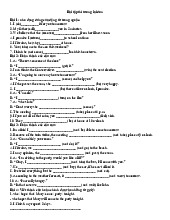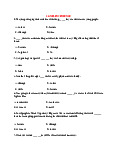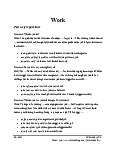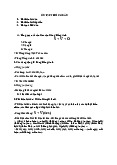












Preview text:
ADVERTISING 1. DEFINITION
DEFINITION OF ADVERTISING:
References from the Internet sources:
Advertising is the practice and techniques employed to bring attention to a product
or service. Advertising aims to put a product or service in the spotlight in hopes of
drawing it attention from consumers. It is typically used to promote a specific
good or service, but there are wide range of uses, the most common being the commercial advertisement.
(From Wikipedia, the free encyclopedia,
https://en.wikipedia.org/wiki/Advertising)
The definition of advertising is an industry used to call the attention of the public
to something, typically a product or service.
The definition of advertisement is the means of communication in which a
product, brand or service is promoted to a viewership in order to attract interest,
engagement, and sales. Advertisements (often shortened to ads or adverts) come
in many forms, from copy to interactive video, and have evolved to become a
crucial feature of the app marketplace. (From Adjust GmbH,
https://www.adjust.com/glossary/advertiseme nt/)
References from the Advanced English Language book:
Advertisements is to draw attention to particular products or services through
announcements paid for by an individual or a group wishing to inform or influence a particular audience.
Advertisers focus their advertising on particular groups of people, divide people
by age, gender, race or social class.
Advertising is a form of propaganda and promotion that businesses will have
to pay a fee to introduce manufactured products or a service to serve potential
customers. The ultimate purpose of advertising is to create a positive impact
on user perception and behavior through the use of images and words to create
customers' interest in that product.
(My definition about advertising)
2. BASIS ELEMENTS IN A PIECE OF ADVERTISING:
A good print advertisement can present your product to new eyes. Successful print ads
convey information about your products and store. They include a clear and specific
offer, along with information about how readers can act on that offer. Not all print ads are
created equal, however. In order to maximize your investment, include all of these
elements in your advertisement. The Offer
A good print advertisement offers readers an immediate benefit or reason to learn more
about your product. This can be anything from a hot new product to a sale or limited-time
discount. Your offer is the hook that draws the reader in and it should be the focus on your ad. The Headline
The ad title offers a short, snappy preview of what the reader will find in the copy. Your
headline explains to the reader the key benefit or offer you are providing. In general,
headlines are the largest part of the advertisement. A good headline keeps a potential
customer reading; a weak headline and the customer turns the page. Image
A print ad includes one or two striking pictures that illustrate your offer. If you are
offering a free product, your ad should include an attractive photo of the product. If you
are highlighting a hot new product or sale, your image should be of that hot new product.
If possible, run your images in color to draw in readers. The Body
The body of your ad includes details about your offer, details about your store or product
and any other information you want to highlight. Keep your body text short and easy-to
read. Use bullet points or subheadings to break up the text. Readers want to get the
information they need as quickly as possible. Call to Action
Include a sense of urgency in your ad. Don't just tell readers about your product, urge
them to take action in order to benefit from your offer. Set a time limit and clear, concise
instructions for what readers should do. Call to action statements include: "Call Today to
Reserve Your Copy," "Only 100 Copies in Store, Come in to Reserve Yours" and "Only
the First 50 Customers Receive a Free T-Shirt, Come in Today."
Contact Information and Store Logo
Your ad should include the address and phone number for your store, along with any
other information a reader needs to follow through on your call to action. Also include a
logo for your product to build up brand recognition. Smart Ad Placement
Once you've designed a successful advertisement, place it in publications that reach your
target market. Before you place your ad, ask the publication for statistics on their
demographics. Choose a publication that reaches potential clients who are the right age,
demographic and income bracket.
Every day we are bombarded by advertisements, but not everyone succeeds, far from it.
In this article we will review those components that cannot be missing from any
advertising spot if we want it to be successful. We will go deeper into each one of them
and see what role it plays in the transmission of the message and the persuasive process that advertising seeks.
Although we believe that advertising is a relatively recent field, this is by no means the
case. To get an idea, we have to know that tablets belonging to merchants of Babylon of
the third millennium before Christ have been found, in which different products and
services were advertised. The same has happened in archaeological excavations in Egypt,
Pompeii, Greece or Rome. The conclusion is that advertising has accompanied humanity
from almost the beginning of history.
Of course, what is true is that since the last century, this field of study has practically
become a science, and that is why countless studies have been carried out to investigate
the elements of an advertising spot in order to determine which styles work best and to be
able to get the most out of each one of them, making our spot achieve the maximum
impact on the audience and thus ultimately achieve more sales of our product or service.
When developing an advertising message, we can try to enhance some of its elements,
and probably in this way we will achieve a certain reception by some consumers. But, if
we really want to create a spot that achieves its effect and draws significant attention to
the group to which it is addressed, we must pay attention to all the elements of a
commercial, and not just one. This is because each part is fulfilling a certain function.
Therefore, we would be talking about a system of synergy in which the different parts,
when brought together, achieve a greater impact than when working separately. That is
why, as they are like complementary pieces of the same puzzle, we should not relegate
any of them to a second position and we should put our efforts in getting the best version
of each of the elements of a commercial. This is the only way to guarantee a good part of the way to commercial success.
The different elements of a commercial
We have already seen the importance of these components, but the most important thing
remains: to know what they are and what characteristics each one of them has. Therefore,
below we will see a list that will allow us to know them and discover their peculiarities,
so that we have a notion of what are the keys that marketing and communication
professionals take into account. 1. The bullet
The first of the elements of an advertisement is the bullet, also called bullet by its English
nomenclature. The name is quite descriptive, because this element, the first of all, has to
act as a shot. Something quick and direct, which provokes a shock in the audience and in
this way manages to attract attention. Because attention is the key to any advertising
campaign. If we manage to catch the attention at the beginning of the message, we will
have a good part of the work done.
The shot is usually a sentence of a few words. Perhaps a question that prompts the
recipient to think and reflect on the answer. A controversial statement can also be used,
something that causes a shock by questioning the viewer's belief system. It doesn't matter,
because we will have resolved that conflict with the rest of the elements of the
commercial, but the important thing is that we will have managed to get the person to
direct his or her gaze and attention to give us a few seconds of his or her time. 2. The header
Once we have managed to capture the attention of the potential client, we have to take
advantage of the situation and strike again with a short message, this time, the headline.
The idea is to tell the viewer what the general idea is that we want to convey throughout
the message, and therefore the header must be short and attractive. It is essential that this
is the case in order to ensure that they continue to pay attention to us and that our
message penetrates their unconscious.
The header, as its own name suggests, must be placed at the top of our ad, since it is
usually where the consumer will look first, and therefore it must be the trap that, like the
bullet, catches the viewer's attention and does not let go, if possible until he or she has
received the complete message that we are trying to convey with all the elements of an ad. 3. Photography
The next element is not verbal, but is an image, a photograph. It serves to support the
message and also to attract the look and with it the attention of the potential consumer. In
that sense, its function would be essentially that of an element of attraction. Many
advertising campaigns resort to the use of photographs of attractive people and also of
public figures, whether from the world of cinema, sport or other fields.
Logically, this strategy entails an economic cost that can sometimes be enormous,
depending on the relevance of that person and therefore the fees required to lend their
image to that campaign. Therefore, it is not something within the reach of all brands. But
even if the face is not known, it can cause a tremendously powerful effect if it fits in with
the message we want to transmit. Of course, you can also choose to show something other than a human face.
In fact, many products are so attractive that the brand chooses to use their image
directly for photography. Likewise, if it is shown in a proper way, it can (and does) work
in a very intense way. Of course, the photograph must have some conditions in terms of
lighting, resolution, angle, composition and many other variables that make it visually
attractive in itself. There is a whole science behind this field. 4. The body of the message
Although all the elements of an ad are important, as we have already seen, the body of
the message may be vital. The ones we have seen so far had the essential function of
capturing the customer's attention, but it is the body that, once the person is looking at us,
has the function of clearly and concisely conveying the message we want to send and,
more importantly, convincing him that the product or service is for him.
The body must be direct. We know that attention time will be very limited and therefore
we cannot waste it with long texts, offering endless explanations of the advantages of our
product. No. It has to be fleeting, a few lines in which all the strengths of what we are
offering are condensed. The perfect message is the one that not only tempts the consumer,
but also convinces him/her that he/she needs to acquire the product. 5. The Logo
Accompanying the message and in a clear place, the logo of the brand must appear. It is
that small image that everyone should associate with our products and that should
provoke a reaction just by seeing it.
There are brands that we all recognize just by appreciating the logo, but others must
build their reputation and image, associated with the quality of their products. In those
cases it will be even more necessary that the logo is clearly appreciated so that customers
can make that visual association. 6. The slogan
One of the elements of an advertisement that usually accompanies the logo is the
slogan. It is a short phrase that must contain a powerful message, a slogan that, just like
the logo, we associate with the brand and causes us a positive emotion every time we
hear or read it. The slogan can be unique for the brand or it can be made for the specific
advertising campaign we are working on.
Some slogans last over time and manage to generate a greater memory than the brand
itself. Therefore, a powerful slogan must be used and we should not replace it with
another one lightly, since we run the risk of weakening the brand image and causing
confusion in the perception of consumers, who may not recognize the product as easily as before. 7. Contact information
The last element of an advertisement is obvious: the contact details. There is no point in
having succeeded in capturing the consumer's attention and convincing him/her to buy
our product and service, if he/she does not know how to do it afterwards. Therefore, it is
necessary that we leave a contact, which can be the address of the store itself (physical or
online), or simply the social networks from which you can contact, such as Facebook, Twitter, Instagram, etc.
3. FUNCTIONS OF ADVERTISING
The main function of advertising
To persuade(cinative function_
To provide information ( referential function) The size The brand name The price The address Telephone number To promote sales
To charity: collecting funds: attracting support and voluntary helpers.
To commercial company: selling goods and services; attracting investment;
changing attitudes; crreating new desires in a target audience; giving
information about a product or service.
To government: giving information; publicizing planning proposals and health and safety issues.
To media: attracting a target audience; selling advertising space.
To event organisers: Promoting events and demonstrations.
To political parties: winning votes; attracting members or financial support.
To private individuals: selling and purchasing goods and services :
announcing personal events and occasions.
To schools, colleges, universities: informing prospective students of
courses, facilities, and future career possibilities.
4. TYPES OF ADVERTISING:
There are two types of advetising -
Commercial: A type of advertising that it is information based on the influence of
technology data to help consumers make informed choices. The main goal of commercial : • to notify • to convince • to remind
• to influence consumers to act and switch brands • to try a new product
• remain loyal to a current brand
- Non-commercial : A type of advertising that is typically for educating consumers or
promoting specific ideas that hopefully people will put to good use. For example, a non-
profit may implement an advertising campaign to increase public awareness and
education about a certain health issue.
+ Non-commercial also has two types: Political and public
The main goal of non-commercial :
• To raise awareness of an issue
• To collect funds for a cause • To promote an idea.
• To entice voters to vote in some way
5. FEATURES OF ADVERTISING LANGUAGE:
WHAT TO LOOK FOR THE LANGUAGE OF ADVERTISING A. REGISTER: •
Mode: Advertisements for different media use different techniques, but a number
of features are common to both spoken and written examples. • Manner: -
the advertiser ( logo, slogan , brand name , distinctive colour or image ) -
the target audience ( age, gender , social status ) -
the function of the advertisement or its message ('buy this', 'give generously', ' join us ', and so on ) - the selling techniques
+ a product - based approach praises the features of a product or service, hoping to
win customers on the strength of the product or service itself
+ an audience - based approach tries to convince the target audience that they need a
particular product or service: by concentrating on practical needs like saving time , or
psychological needs like the desire to look better or younger , advertisers try to persuade
consumers that their lives will be better if they use a certain product or service.
+ an impact - based approach aims to attract attention linguistically or dal use a
certain product or service visually. •
Field: of information as they can in order to attract audience and viewers.
The most far-reaching mainstream source of product advertising can be found in
magazines and newspapers, on billboards and on television . These kinds of
advertisements are an everyday part of our lives and we take them for granted.
They use typical rhetorical techniques to influence their intended audience, and juxtapose
slogans, copy and images to evoke an appropriate response. B. OVERALL DESIGN - Images
The images will also attract the attention of the intended audience: they are a form of
non - verbal communication. The people, the settings , the props ( objects used in a
particular context to create a sense of reality ) and the product itself together make up the
image . Each element can work in both a literal and a symbolic way.
Advertisers use cultural stereotypes in their images so that they can be sure that their
target audience will associate good things with a product or service. Women are
invariably beautiful; children are angelic ; men are strong and rugged ; and young people
are up to date with current trends . Props help to create these stereotypes -glasses
symbolise cleverness; books symbolise education; beer has connotations of masculinity ;
and so on . By breaking down the codes that are used in the images , it is possible to learn
something about the advertisers ' intentions even before reading the copy. - Other factors
Television product advertisements rely far more heavily on images, and it because
these are often animated by actors the images are far more powerful. The words and
actions together aim to reveal new ways of visualising people, places and events.
The logo and slogan have exactly the same form as they would in a magazine or
newspaper advertisement, and this allows advertisers go to create a consistent brand
identity across a range of media. The copy of a writ-ten advertisement might be delivered
by a voice-over in which an unseen speaker draws attention to certain features of a product. C. LEXIS Slogan
- A SLOGAN is crucial if an advertising campaign is to succeed, because it is the
slogan that will stick in people's minds.
- Advertisers can use puns, disrupt
collocations, or work on our emotions, but whatever approach a particular campaign
uses, the slogan is always made eye-catching. Lexical choice
- LEXICAL CHOICE: convey the essential points in a concise and dramatic way.
- The copy of an advertisement can have two functions:
Modifiers: can be used to emphasise the positive attributes of a product in order to
persuade a consumer to buy it (conative function).
The written text: can provide technical facts about the product to inform the consumer,
of size, power, range of features, price and so on (referential function).
- The language of advertising can also influence the contemporary word stock.
Colloquial expressions can now be heard in everyday conversation.
Adjective phrases can become catchphrases.
Sentences can use distinctive patterns that are memorable. Noun phrases
- The structure of noun phrases is often complex, with strings of pre-modifiers and
post-modifiers being used. The use of both kinds of modification provides precise
information in a concise way, but the complex noun phrases of advertising can be a
substitute for clear and honest description. Modifiers
- Modifiers are a distinctive feature of advertising language because of their
power in attracting attention. Because they allow advertisers to evoke the kind of
image they want to associate with a particular product or service, modifiers are described as TRIGGER WORDS. Possessive form of nouns
- The possessive form of nouns is often used with inanimate objects in advertising
language, and this is not common in any other variety. Neologism
- New words are also coined by using the brand name of an item as the basis for a word.
- Often non-standard spelling will be used to attract attention. D. GRAMMAR Spoken language
- The grammar of advertisements is also similar to informal spoken language. (https://youtu.be/_lesaHjHE) Mood
- Through variations in mood, the advertisers appeal to their target audience to take notice and to act. Tense
- Verb tenses allow the advertisers to implicitly convey differences in the semantics.
Simple present tense: emphasises features of a product.
Simple past tense: the perfect aspect allow advertisers to draw comparisons.
Simple future time: often constructed using the modal verb will, makes assumptions
about what is possible if the consumer uses a particular product or service. Pronouns
- Pronouns help advertisers create a personal relationship with consumers.
- By using the second person pronoun you. E. STYLE • Sentence organization
- Uses grammatical patterning to rearange the elements of a sentence in order to draw attention to key information. • Literary device: -
To attract attention to the product -
Can construct different layers of meaning:
+ Metaphors link emotive associations to a product.
+ Symbol likewise encour-ages viewer to make certain connections that will colour their view.
+ Personification or animation of inanimate objects can create a mysterious or comic atmosphere.
+ Ambiguity can both create humor and provoke interest. •
Sound patterning: makes slogans and copy stand out. •
Rhetorical device: create patterns at the level of words and clauses.
- Antithesis for dramatic effect
- Listing indicates specific features that may attract the buyer.
- Patterning to draw attention to a product or its features.
- Repetition highlights key points or a particular brand name.
F. TYPOGRAPHICAL FEATURES
- Can help consumers to identify certain brands or products.
- Print size and shape, colour and layout become as significant as the language in
persuading readers and viewers to act in the way the advertisers intend.




